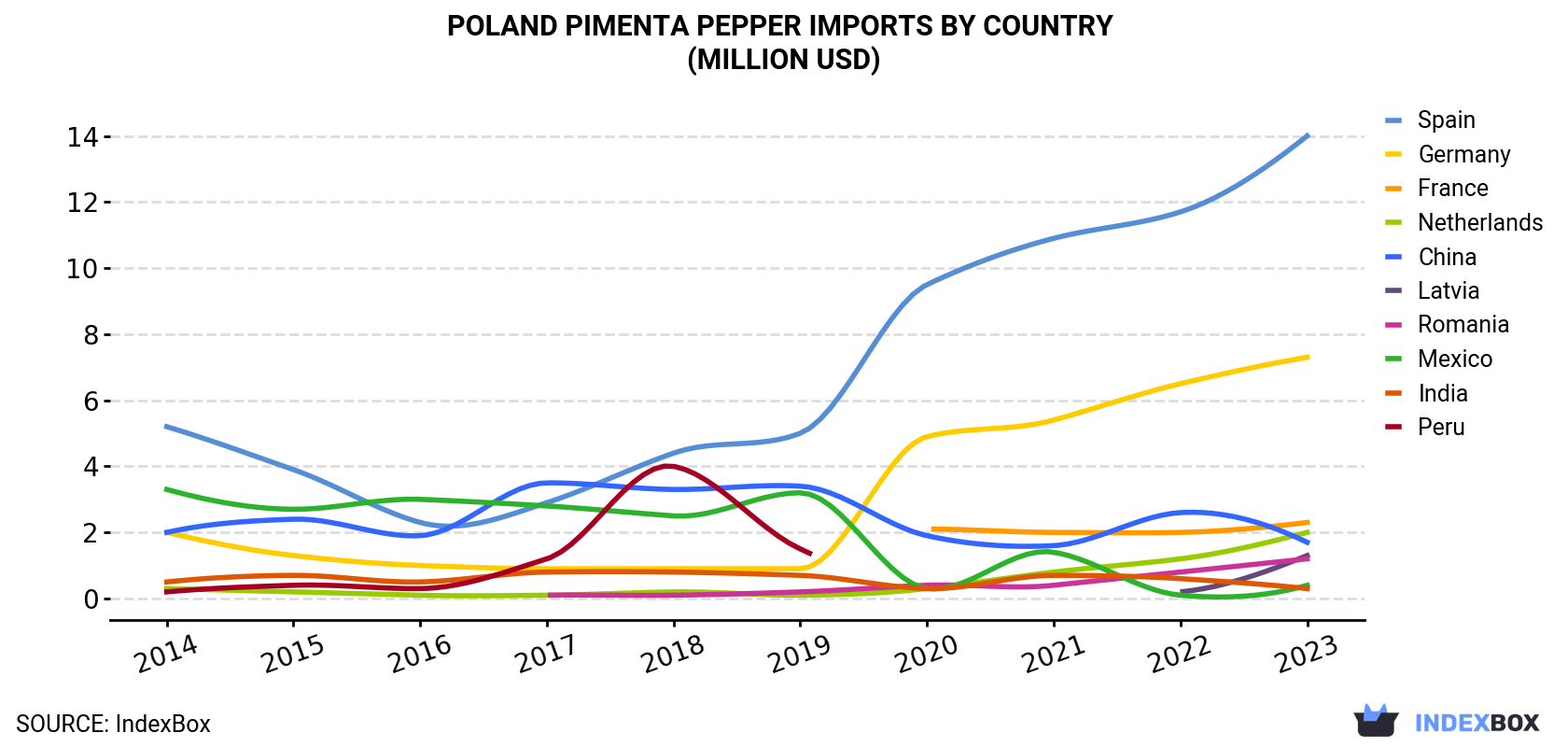Feb 19, 2025
Poland Pimenta Pepper Imports
In 2024, supplies from abroad of pimenta pepper decreased by -18.4% to 5.8K tons, falling for the second year in a row after three years of growth. Overall, total imports indicated measured growth from 2014 to 2024: its volume increased at an average annual rate of +2.1% over the last decade. The trend pattern, however, indicated some noticeable fluctuations being recorded throughout the analyzed period. Based on 2024 figures, imports decreased by -22.4% against 2022 indices. The most prominent rate of growth was recorded in 2020 when imports increased by 31%. Over the period under review, imports reached the peak figure at 7.5K tons in 2022; however, from 2023 to 2024, imports failed to regain momentum.
In value terms, pimenta pepper imports fell dramatically to $25M (IndexBox estimates) in 2024. In general, imports, however, continue to indicate noticeable growth. The pace of growth appeared the most rapid in 2020 with an increase of 35% against the previous year. Imports peaked at $32M in 2023, and then dropped notably in the following year.
Imports by Country
In 2023, Spain (3.5K tons) constituted the largest supplier of pimenta pepper to Poland, accounting for a 49% share of total imports. Moreover, pimenta pepper imports from Spain exceeded the figures recorded by the second-largest supplier, Germany (1.5K tons), twofold. China (730 tons) ranked third in terms of total imports with a 10% share.
From 2014 to 2023, the average annual rate of growth in terms of volume from Spain amounted to +7.5%. The remaining supplying countries recorded the following average annual rates of imports growth: Germany (+22.3% per year) and China (+1.1% per year).
In value terms, Spain ($14M), Germany ($7.3M) and France ($2.3M) were the largest pimenta pepper suppliers to Poland, together comprising 74% of total imports. the Netherlands, China, Latvia, Romania, Mexico, India and Peru lagged somewhat behind, together comprising a further 21%.
Romania, with a CAGR of +158.3%, recorded the highest rates of growth with regard to the value of imports, in terms of the main suppliers over the period under review, while purchases for the other leaders experienced more modest paces of growth.
Import Prices by Country
In 2023, the pimenta pepper price stood at $4,480 per ton (CIF, Poland), surging by 23% against the previous year. Over the last nine-year period, it increased at an average annual rate of +3.0%. As a result, import price reached the peak level and is likely to continue growth in the immediate term.
Prices varied noticeably by country of origin: amid the top importers, the country with the highest price was France ($8,767 per ton), while the price for China ($2,277 per ton) was amongst the lowest.
From 2014 to 2023, the most notable rate of growth in terms of prices was attained by France (+12.1%), while the prices for the other major suppliers experienced more modest paces of growth.
This report provides an in-depth analysis of the pimenta pepper market in Poland. Within it, you will discover the latest data on market trends and opportunities by country, consumption, production and price developments, as well as the global trade (imports and exports). The forecast exhibits the market prospects through 2030.
Product coverage:Country coverage:Data coverage:Market volume and valuePer Capita consumptionForecast of the market dynamics in the medium termTrade (exports and imports) in PolandExport and import pricesMarket trends, drivers and restraintsKey market players and their profilesReasons to buy this report:Take advantage of the latest dataFind deeper insights into current market developmentsDiscover vital success factors affecting the market
This report is designed for manufacturers, distributors, importers, and wholesalers, as well as for investors, consultants and advisors.
In this report, you can find information that helps you to make informed decisions on the following issues:
How to diversify your business and benefit from new market opportunitiesHow to load your idle production capacityHow to boost your sales on overseas marketsHow to increase your profit marginsHow to make your supply chain more sustainableHow to reduce your production and supply chain costsHow to outsource production to other countriesHow to prepare your business for global expansion
While doing this research, we combine the accumulated expertise of our analysts and the capabilities of artificial intelligence. The AI-based platform, developed by our data scientists, constitutes the key working tool for business analysts, empowering them to discover deep insights and ideas from the marketing data.
